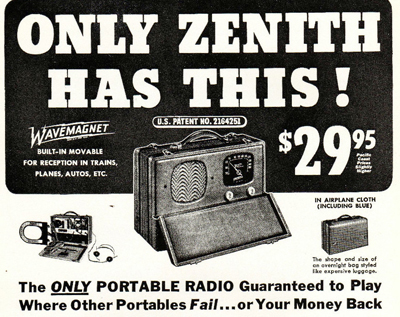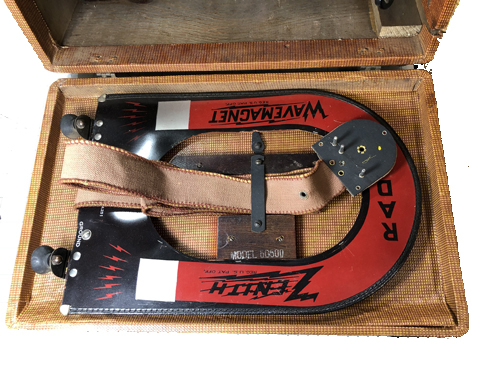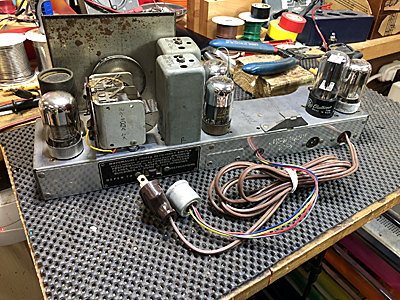Zenith Universal Radio
Universal Model 5G500
1941 -1942

 During the late 1930's, Zenith introduced a number of portable AM radios. Introcuced in 1941, the Zenith 5G500 was not a particularly attractive radio, but it holds a place of historical significance in the evolution of Zenith portable tube radios, especially the line of Zenith Trans-Oceanic radios, produced in various models from 1941 to 1963.
During the late 1930's, Zenith introduced a number of portable AM radios. Introcuced in 1941, the Zenith 5G500 was not a particularly attractive radio, but it holds a place of historical significance in the evolution of Zenith portable tube radios, especially the line of Zenith Trans-Oceanic radios, produced in various models from 1941 to 1963.
The Zenith 5G500 is of historical interest as it introduced the patented Zenith Wavemaget antenna. This Wavemagnet was an important part of the first Zenith Trans-Oceanic radio introduced in 1941. Featuring a horseshoe design with hinged suction cups on the base, the antenna was designed to be attached to the window of a bus or railroad passenger car, or a window in a steel building, enabling reception of radio waves that would otherwise be blocked by the steel.
The Wavemagnet antenna, modified for both AM and SW reception, appeared with the very first Trans-Oceanic model, also introduced in 1941. The Wavemagnet was carried over to the first Post-WWII model, the 8G005, introduced in 1947. It was dropped in favor of a redesigned antenna, still called a Wavemagnet, introduced with the G500 models, and further evolved in the 600 series Trans-Oceanics.
Restoration consisted of the usual replacement of electrolytic and paper/wax capacitors, along with any resistors that tested high. I replaced the yellowed and shrunken dial cover with a new reproduction from Mark Palmquist at dialcover.com. The airplane cloth covering on the cabinet has some wear, fraying, and scuffing, but otherwise wasn't in too of bad shape, so I left it alone. It was missing the handle, so I found a replacement online and installed it, which required drilling and driving out the rivets that secure the handle holders. I replaced the rivets with nuts and bolts. I need to paint them to match the other hardware, though.
 The Zenith 5G500 uses a Z-675 battery. The A voltage for the filaments is 6 volts, provided by four D cells in series. The B voltage is 75 volts, and I used eight 9-volt cells in series for it. The eight 9-volt cells produce a nominal voltage of 72 volts, but when newly installed, the voltage is actually 77 volts, above the 75 volts specified for the radio.
The Zenith 5G500 uses a Z-675 battery. The A voltage for the filaments is 6 volts, provided by four D cells in series. The B voltage is 75 volts, and I used eight 9-volt cells in series for it. The eight 9-volt cells produce a nominal voltage of 72 volts, but when newly installed, the voltage is actually 77 volts, above the 75 volts specified for the radio.
You can view a video of this radio on You Tube.





Return to Trans-Oceanic Gallery
Home
 The Zenith 5G500 uses a Z-675 battery. The A voltage for the filaments is 6 volts, provided by four D cells in series. The B voltage is 75 volts, and I used eight 9-volt cells in series for it. The eight 9-volt cells produce a nominal voltage of 72 volts, but when newly installed, the voltage is actually 77 volts, above the 75 volts specified for the radio.
The Zenith 5G500 uses a Z-675 battery. The A voltage for the filaments is 6 volts, provided by four D cells in series. The B voltage is 75 volts, and I used eight 9-volt cells in series for it. The eight 9-volt cells produce a nominal voltage of 72 volts, but when newly installed, the voltage is actually 77 volts, above the 75 volts specified for the radio. 
 During the late 1930's, Zenith introduced a number of portable AM radios. Introcuced in 1941, the Zenith 5G500 was not a particularly attractive radio, but it holds a place of historical significance in the evolution of Zenith portable tube radios, especially the line of Zenith Trans-Oceanic radios, produced in various models from 1941 to 1963.
During the late 1930's, Zenith introduced a number of portable AM radios. Introcuced in 1941, the Zenith 5G500 was not a particularly attractive radio, but it holds a place of historical significance in the evolution of Zenith portable tube radios, especially the line of Zenith Trans-Oceanic radios, produced in various models from 1941 to 1963.



